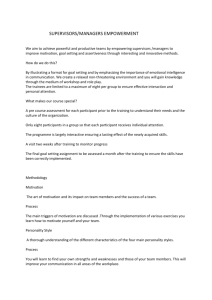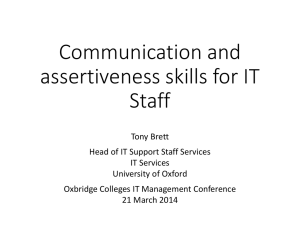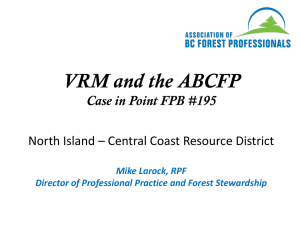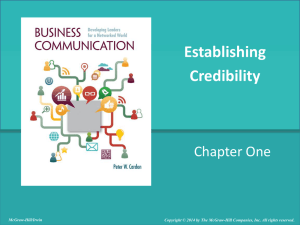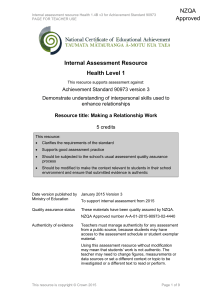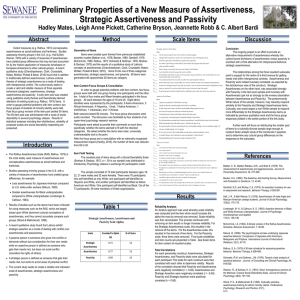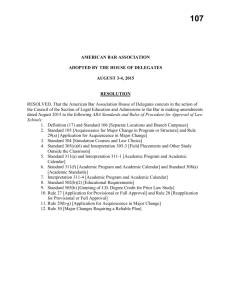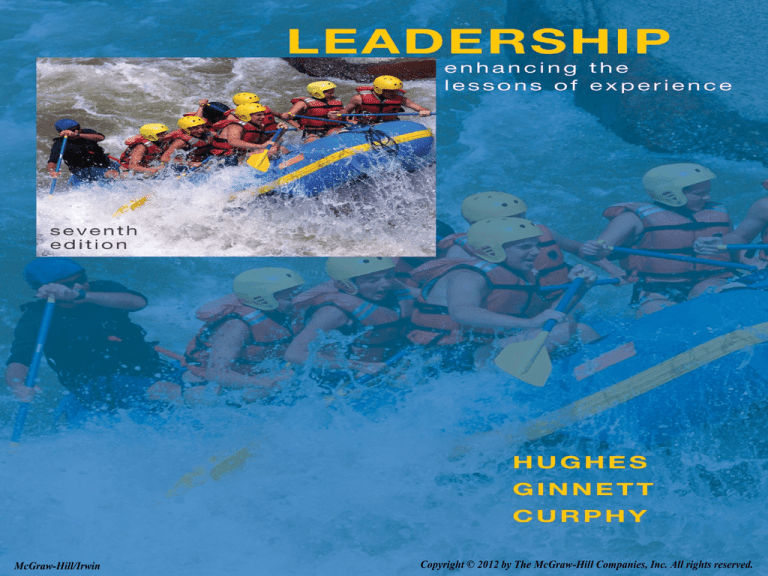
McGraw-Hill/Irwin
8-1
Copyright © 2012 by The McGraw-Hill Companies, Inc. All rights reserved.
Chapter
8
Skills for Building
Personal Credibility
and Influencing Others
8-2
Introduction
This chapter will concentrate on the following
basic skills leaders need:
• Building credibility.
• Communication.
• Listening.
• Assertiveness.
• Conducting meetings.
• Effective stress management.
• Problem solving.
• Improving creativity.
8-3
Building Credibility
Credibility is the ability to engender trust in others. It
is comprised of two components:
• Expertise - building expertise involves increasing
one’s knowledge and skills in the areas of technical
competence, organizational knowledge, and industry
knowledge.
• Trust – is comprised of clarifying and communicating
your values, and building relationships with others
8-4
The Credibility Matrix
Figure 8.1: The Credibility Matrix
Source: G. J. Curphy, Credibility: Building Your Reputation throughout the Organization (Minneapolis Personnel Decisions
International, 1997).
8-5
The Credibility Matrix Explained
Leaders who are in each quadrant have different
interactions with followers.
• First quadrant - have a high level of trust and a high level of
expertise; they would likely be seen by others as highly
credible.
• Second quadrant - might include leaders who have spent
little time with followers, who do not follow through with
commitments, or who are new to the organization and have
had little time to build relationships with coworkers.
• Third quadrant - may be new college hires or people joining
the company from a different industry. Unlikely they would
have technical competence, organizational or industry
knowledge, or time to build relationships with coworkers.
• Fourth quadrant - may include those promoted from among
peers or transferring from another department within the
company.
8-6
Communication
Figure 8.2: A Systems
View of Communication
8-7
Ways to improve communication
Leaders can improve their communication
through a number of different means including:
• Know What Your Purpose Is.
• Choose an Appropriate Context and Medium.
• Send Clear Signals
• Actively Ensure That Others Understand the
Message
8-8
Listening
• It is important to remember that listening to others
is just as important to good communication as is
expressing yourself clearly.
• Leaders are only as good as the information they
have, and much of that information comes from
watching and listening to what is going on around
them.
• The best listeners are active listeners.
• Passive listeners are not focused on
understanding the speaker.
8-9
Active Listening
4 ways to improve active listening skills include:
• Demonstrate Nonverbally That You Are Listening.
• Actively Interpret the Sender’s Message.
• Attend to the Sender’s Nonverbal Behavior.
• Avoid Becoming Defensive.
8-10
Assertiveness
• Assertive behavior allows someone to be able to
stand up for their own rights (or their group’s
rights) in a way that also recognizes the
concurrent right of others to do the same.
8-11
Assertiveness
• Assertive behavior allows someone to be able to
stand up for their own rights (or their group’s
rights) in a way that also recognizes the
concurrent right of others to do the same.
• It is different from acquiescence and
aggression.
• Acquiescence is avoiding interpersonal conflict
entirely either by giving up and giving in or by
expressing our needs in an apologetic, selfeffacing way.
• Aggression is an effort to attain objectives by
attacking or hurting others
8-12
Assertiveness, Acquiescence and
Aggression.
Figure 8.4: Relationships between Assertiveness, Acquiescence, and Aggression
8-13
Developing Assertiveness
We can do several things to behave more
assertively:
• Using “I” statements
• Speaking up for what we need
• Learning to say no
• Monitoring our inner dialogue
• Being persistent.
8-14
Conducting meetings
Seven helpful tips for running meetings from Guth
and Shaw:
• Determine Whether It Is Necessary
• List the Objectives
• Stick to the Agenda
• Provide Pertinent Materials in Advance
• Make It Convenient
• Encourage Participation
• Keep a Record
8-15
Stress
• Stress - the process by which we perceive and
respond to situations that challenge or threaten us.
• Responses may include:
• Increased levels of emotional arousal
• Changes in physiological symptoms(increases in perspiration,
heart rate, cholesterol level, or blood pressure).
• Stress often occurs in situations that are complex,
demanding, or unclear.
• Stressors - specific characteristics in individuals,
tasks, organizations, or the environment that pose
some degree of threat or challenge to people.
• Stress can either facilitate or inhibit performance,
depending on the situation
8-16
Effective Stress Management
• Monitor Your Own and Your Followers’ Stress
Levels.
• Identify What Is Causing the Stress.
• Practice a Healthy Lifestyle.
• Learn How to Relax.
• Develop Supportive Relationships.
• Keep Things in Perspective.
• The A-B-C Model:|
– A) Triggering Event
– B) Your Thinking
– C) Feelings and Behaviors
8-17
Steps in Problem Solving
• Identifying Problems or Opportunities for
Improvement
• Analyzing the Causes
• Developing Alternative Solutions
• Selecting and Implementing the Best Solution
• Assessing the Impact of the Solution
8-18
Cause and Affect Analysis
Figure 8.5: A Cause-and-Effect Diagram
8-19
Selecting and Implementing the Best
Solution
Figure 8.6: Force Field Analysis Example: Starting a Personal Exercise Program
8-20
Improving creativity
There are several ways to increase creativity:
• Seeing Things in New Ways
– Think in terms of analogies
– Try putting an idea or problem into a picture rather than
into words
• Using Power Constructively
• Forming Diverse Problem-Solving Groups
8-21

